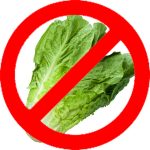The November 2018 outbreak of E.coli O157:H7 infections linked to romaine lettuce caused 62 illnesses across 16 states. The FDA zeroed in on the Central Coast growing regions of northern and Central California as being responsible for the contamination. The outbreak was declared over on January 9 and yesterday FDA released the report, “Factors Potentially Contributing to the Contamination of Romaine Lettuce Implicated in the Fall 2018 Multi-State Outbreak of E.Coli O157:H7”, which provides an overview of the investigation.
The report states that a sediment sample coming from an on-farm water reservoir in Santa Maria (Santa Barbara County, California) tested positive for the outbreak strain of E. coli O157:H7. Although this particular farm was identified in several legs of the Fall 2018 traceback investigations that occurred in the United States and Canada, as well as being a possible supplier of romaine lettuce in the 2017 traceback investigations, the FDA said that the farm is not the single source of the outbreak, as there is “insufficient evidence”. The traceback suggests that the contaminated lettuce could have come from several farms, because not all tracebacks led to the farm on which the contaminated sediment was found.
“The finding of the outbreak strain in the sediment of the water reservoir is significant, as studies have shown that generic E. coli can survive in sediments much longer than in the overlying water. It’s possible that the outbreak strain may have been present in the on-farm water reservoir for some months or even years before the investigation team collected the positive sample. It is also possible that the outbreak strain may have been repeatedly introduced into the reservoir from an unknown source,” stated FDA Commissioner Scott Gottlieb, M.D. and Deputy Commissioner Frank Yiannas in a press announcement.

Although the exact route of contamination cannot be confirmed, the FDA hypothesizes that it could have occurred through the use of agricultural water from an open reservoir, which has increased potential for contamination.
The investigation teams also found evidence of “extensive” wild animal activity and animal burrows near the contaminated reservoir, as well as adjacent land use for animal grazing, all of which could have contributed to the contamination.
Although FDA did not directly name the farm in the report, it provided a link about the recall that was initiated by the farm, Adam Bros. Farming, Inc., in December.
Considering the significant effect that the past two E.coli outbreaks involving romaine lettuce have had on both the public as well as the produce industry, FDA made several recommendations on preventive measures that leafy greens growers and industry can take to avoid such pathogenic contamination, including:
For growers:
- Assessing growing operations to ensure they are in line with compliance to FSMA and good agricultural practices
- Making sure that any agricultural water that comes into direct contact with the harvestable portion of the crop, food contact surfaces and harvest equipment is safe and sanitary
- Address and mitigate risks associated with agricultural water contamination that can occur as a result of intrusion by wild animals
- Address and mitigate risks associated with the use of land near or adjacent to agricultural water sources that can lead to contamination
- Conduct root cause analysis whenever a foodborne pathogen is identified in the growing environment, agricultural inputs like water or soil, raw agricultural commodities, or “fresh-cut” ready-to-eat produce
For the broader industry:
- The development of real-time procedures that enable rapid examination of the potential scope, source and route of contamination
- All leafy green products should have the ability to be traced back to the source in real time, and information include harvest date. In November, FDA requested voluntary labeling [https://foodsafetytech.com/news_article/cdc-alert-do-not-eat-romaine-lettuce-throw-it-out/] to help consumers identify products affected during an outbreak
- The adoption of best practices in supply chain traceability
Resources
- FDA report: “Factors Potentially Contributing to the Contamination of Romaine Lettuce Implicated in the Fall 2018 Multi-State Outbreak of E.Coli O157:H7”
- FDA statement from Commissioner Scott Gottlieb, M.D. and Deputy Commissioner Frank Yiannas
- FDA investigation of source of E.coli O157:H7 outbreak linked to romaine lettuce







